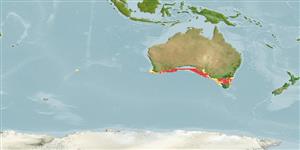Elasmobranchi (squali e razze) (sharks and rays) >
Carcharhiniformes (Ground sharks) >
Pentanchidae (Deepwater catsharks)
Etymology: Asymbolus: Etymology not explained, possibly a-, Latin privative, i.e., without; sym-, from syn (Gr.), together or joined; bolus (L.), lump or morsel, proposed as a subgenus of Scyliorhinus (Scyliorhinidae) distinguished in part by labial fold of upper lip not hanging over lower-jaw symphysis of A. analis and A. vincenti. (See ETYFish); vincenti: Etymology not explained, probably named for Gulf St Vincent, where Kangaroo Island (southern coast of Australia), type locality, is situated. (See ETYFish).
Environment: milieu / climate zone / depth range / distribution range
Ecologia
marino associati a barriera corallina; distribuzione batimetrica 27 - 650 m (Ref. 75154). Temperate; 33°S - 42°S
Eastern Indian Ocean: Australia.
Size / Peso / Age
Maturity: Lm ? range ? - ? cm
Max length : 61.0 cm TL maschio/sesso non determinato; (Ref. 244)
Widespread on the continental shelf and slope edge (Ref. 244). Oviparous, with a single egg-case to each oviduct at a time (Ref. 244).
Life cycle and mating behavior
Maturities | Riproduzione | Spawnings | Egg(s) | Fecundities | Larve
Oviparous, paired eggs are laid. Embryos feed solely on yolk (Ref. 50449).
Last, P.R. and J.D. Stevens, 1994. Sharks and rays of Australia. CSIRO, Australia. 513 p. (Ref. 6871)
IUCN Red List Status (Ref. 130435)
Human uses
Pesca: di nessun interesse
Strumenti
Special reports
Download XML
Fonti Internet
Estimates based on models
Preferred temperature (Ref.
123201): 11.8 - 15.8, mean 14.2 °C (based on 22 cells).
Phylogenetic diversity index (Ref.
82804): PD
50 = 0.5020 [Uniqueness, from 0.5 = low to 2.0 = high].
Bayesian length-weight: a=0.00355 (0.00176 - 0.00714), b=3.09 (2.91 - 3.27), in cm total length, based on LWR estimates for this (Sub)family-body shape (Ref.
93245).
Trophic level (Ref.
69278): 4.5 ±0.80 se; based on food items.
Resilienza (Ref.
120179): Basso, tempo minimo di raddoppiamento della popolazione 4.5 - 14 anni (Fec assumed to be <100).
Fishing Vulnerability (Ref.
59153): Moderate vulnerability (44 of 100).
